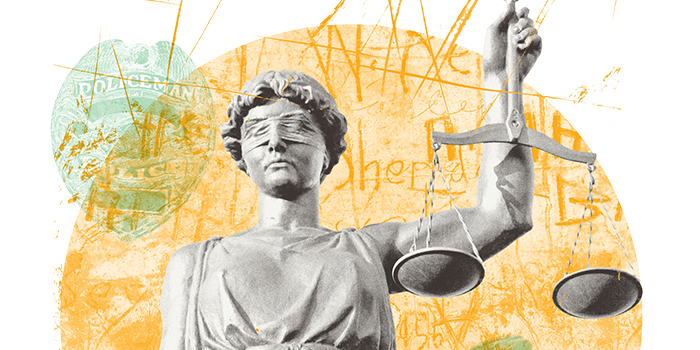Last week, the Department of Justice issued a report finding that the Minneapolis Police Department routinely used excessive force against Black and Indigenous people, and that George Floyd’s murder arose from this pattern of misconduct. They will now negotiate a consent decree with the city of Minneapolis to institute reforms. The report is damning, and it offers a view into an often-obscured problem of police violence.
Police violence is common across police departments, and it leads to trauma, injury, and killings in primarily Black, . State and local authorities — who are responsible for most of America’s police — should not wait for a federal investigation before they address police violence. They can start now by building interlocking reforms that advance three key goals: reduce, rectify, and repair.
Police Violence Isn’t Limited to Police Killings
What do we mean by “police violence”? Police violence stems from this country’s history of using police to oppress marginalized people. American policing has never been a neutral institution. It perpetuates racism and oppression by design. From “slave patrols” that used terror and torture against enslaved Black people engaged in uprisings, to armed militia that enforced Black Codes and Jim Crow, to police that subverted labor unions to benefit political elites in the 19th century, policing has always been tied to suppression, surveillance, and control.
Police violence is not only when officers kill. It’s also the use of excessive force. It’s when police throw people into walls, onto pavement, or against cars. It’s when police punch and kick people who are face down on the ground. It’s when police pull tasers or guns on people who are compliant or restrained — a practice the Justice Department documented in Minneapolis. In heavily policed communities, police violence is a brushfire that steadily burns.
When police kill people, it’s often a flare-up of that brushfire. After a high profile killing, the police department responsible frequently faces an investigation that uncovers a pattern of abusive and biased practices. Nearly 25 years ago, after the NYPD killed Amadou Diallo — an unarmed Black man — in a hail of 41 bullets, an investigation by the New York Attorney General found that the NYPD was stopping alarming numbers of Black and people without proper cause. In more recent years, Breonna Taylor was shot and killed by Louisville police while she slept in her home. An investigation by the Department of Justice later found that Louisville’s police department had a widespread practice of excessive force and “an aggressive style of policing” against marginalized people. The Minneapolis report is yet another example on a long list.
Ending Police Violence Requires Culture Change
Prohibitions are not enough to solve the problem. When an NYPD officer killed Eric Garner using a chokehold in 2014, chokeholds were illegal in New York. The policy could not save Mr. Garner because the NYPD had for years pressured officers to aggressively stop-and-frisk Black people like him. The NYPD has long had policies regulating the use of force, including a training on the subject since 2016. Yet in a lawsuit one of us brought against the NYPD concerning an incident in 2020, officers punched and stomped on a 59-year-old Black man lying on the ground while calling him racial epithets. In another recent case, NYPD officers hit and kicked a 29-year-old Palestinian-American student whose hands were zip-tied behind his back; they pulled his head scarf over his eyes before beating him.
Reduce, Rectify, Repair
The disconnect between paper and practice in part results from bias. It also results from officers being directed to engage in abusive tactics; from officers seeing that excessive force is condoned and not condemned, to political fearmongering about “criminals.” While we need policies prohibiting excessive force, we also need to dismantle oppressive and biased police practices that fuel the fire.
That can’t be done with one-size-fits-all strategies. Rather, extinguishing the conditions that breed violence among police requires implementing interlocking measures that simultaneously advance three objectives: reduce, rectify and repair. “Reduce” means reducing our reliance on police where armed responders are not needed and limiting police discretion in areas where bias and aggression are common, like stop-and-frisk. “Rectify” means establishing mechanisms inside and outside the police department that interrupt and prevent police violence, such as civilian review boards with subpoena power and systems that require departments to act on complaints from the public to ensure accountability and transparency. “Repair” means ensuring the harms from police violence are redressed, which includes compensating those injured and empowering the impacted community to design accountability and safety measures on their terms.
Examples of changes advancing these objectives exist around the country. Philadelphia removed police from enforcing minor traffic violations like broken taillights that were unfairly used against Black people. The NYPD was ordered to incorporate complaints against officers in an early intervention system that triggers remedial action. And Chicago launched initiatives to redress police torture that included payment to victims, education funds for victim’s families, and community-designed health supports.
As James Baldwin said, “responsibility cannot be lost, it can only be abdicated. If one refuses abdication, one begins again.” State and local authorities must not abdicate their responsibility to end police violence; they must act now to protect communities.
Published June 22, 2023 at 03:42PM
via ACLU (https://ift.tt/Bbv5XmQ) via ACLU


